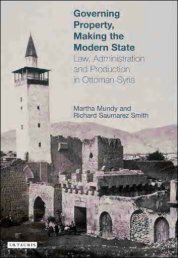The Young Turk Period, 1908-1918 - PSI424
The Young Turk Period, 1908-1918 - PSI424
The Young Turk Period, 1908-1918 - PSI424
You also want an ePaper? Increase the reach of your titles
YUMPU automatically turns print PDFs into web optimized ePapers that Google loves.
296 <strong>The</strong> Rise of Modern <strong>Turk</strong>ey, 1808-1975<br />
retention of Edirne and eastern Thrace but to keep the London Conference going<br />
at least long enough for him to restore the army and appease the public at home.<br />
He proposed a compromise to the powers, agreeing to cede only the portions of<br />
Edirne on the right bank of the Maritsa, retaining the main part of city on the left<br />
bank, where most of the Muslim population as well as the ancient mosques and<br />
tombs were located. <strong>The</strong> powers could decide the fate of the Aegean Islands, but<br />
the Porte would have to retain some, since they were necessary for the defense<br />
of Anatolia. Finally, he added something new-that in return the powers allow<br />
the empire to set its own customs duties, apply the same taxes to foreigners in the<br />
empire as to Ottomans, and, eventually, to abolish the rest of capitulatory provisions<br />
(January 30, 1913). 90 But the Bulgarians refused the territorial proposals,<br />
and the London Conference broke up.<br />
<strong>The</strong> armistice ended on February 3, and the bombardment of Edirne resumed.<br />
<strong>The</strong> Bulgars now began a campaign of slaughtering thousands of <strong>Turk</strong>ish peasants<br />
in Thrace, sending hundreds more toward the capital to disrupt further its ability<br />
to support the war. <strong>The</strong> Bulgars also began a general assault at Catalca, but they<br />
were beaten back again after two weeks of continuous fighting (March 18-30).<br />
However, Mahmut §evket was unable to restore the army because of lack of<br />
money. On March 28 Edirne was starved into submission, leading to a reign of<br />
terror from which the city has never fully recovered. Already on March 6 Janina<br />
had fallen to the Greeks. Isjcodra fell on April 22, thus finally ending Ottoman rule<br />
in Europe with the exception of Istanbul. Kamil Pa§a tried to use the situation to<br />
organize a countercoup that would totally eliminate the CUP and restore the<br />
Liberal Union to power. Traveling to Cyprus and Egypt, he seems to have secured<br />
British support in return for promises to surrender the key administrative and<br />
financial positions in the government to foreign experts. 91 His plans were discovered<br />
by the government, however, and on his return to Istanbul he was arrested<br />
(May 28, 1913). In the meantime, in the face of all the disasters Mahmut §evket had<br />
to offer a restoration of the truce and full acceptance of the powers' peace terms<br />
(March 31, 1913). <strong>The</strong> armistice was restored on April 16, negotiations resumed<br />
on May 30, and ten days later the Treaty of London was signed, with the Midye-<br />
Enez line being established as the new Ottoman boundary and with Thrace and<br />
Edirne in. enemy hands. <strong>The</strong> Porte surrendered all rights in Crete and left the<br />
settlement of the Aegean Islands and the Albanian boundaries to the powers. 92<br />
Kamil Pa§a remained under arrest, but the Liberal Union plans for a coup continued<br />
and were actually intensified by the Treaty of London. Plans were made to<br />
assassinate not only the grand vezir but also the major CUP men to gain revenge<br />
for the attack on the Porte and removal of Kamil. In the end, however, only<br />
Mahmut §evket was gunned down, at Bayezit Square while motoring from the<br />
Ministry of War to the Porte. Cemal Pa§a immediately put the capital under martial<br />
law. Several of the assassins were caught and the ringleaders put under arrest.<br />
<strong>The</strong> CUP took full control after the assassination. Members of the Liberal Union<br />
not implicated in the murder were arrested and sent into exile. A court martial<br />
convicted and sentenced to death 16 Liberal Union leaders, including Prince Sabaheddin<br />
(in absentia) and a number of soldiers involved in the assassination. 93<br />
<strong>The</strong> CUP appointed one of its members, Mehmet Sait Halim Pa§a, an Egyptian<br />
prince and a grandson of Muhammad Ali, as grand vezir, and four other committee<br />
members were assigned key cabinet positions. Thus began the CUP dictatorship<br />
that was to carry the empire to disaster in World War I (June 12, 1913). 94












